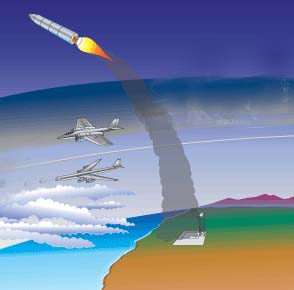Study: Frequent space missions are harming “ozone layer”
 The frequent launches of space rockets are harming the protective ozone layer of Earth - that's what the US atmospheric researchers have warned in their recent study. The scientists have cautioned and advised that the space missions should be restricted as rocket launches are damaging the stratospheric ozone layer.
The frequent launches of space rockets are harming the protective ozone layer of Earth - that's what the US atmospheric researchers have warned in their recent study. The scientists have cautioned and advised that the space missions should be restricted as rocket launches are damaging the stratospheric ozone layer.
The study - conducted by Professor Darin Toohey (atmosphere and ocean scientist) from University of Colorado at Boulder, Patrick Ross of Embry-Riddle Aeronautical University in Daytona Beach, Florida, and Martin Ross and Manfred Peinemann of the Aerospace Corp. in Los Angeles - has warned the growing trend of space missions and space tourism could have pernicious effect on the ozone layer.
The researchers have warned that the magnitude of damage to the ozone layer caused by rocket launches in the recent times is greater than harm caused by chlorofluorocarbons (CFCs), banned chemical compounds for use in aerosols, freezers, and air conditioners.
"As the rocket launch market grows, so will ozone-destroying rocket emissions. If left unregulated, rocket launches by the year 2050 could result in more ozone destruction than was ever realized by CFCs," Professor Darin Toohey has warned.
In the study calling for limiting the space launches because of stratospheric ozone depletion, the researchers have stated that the Montreal Protocol banned the use of Chlorofluorocarbons (CFCs) in aerosol cans, freezer refrigerants and air conditioners in 1987, with a hope that ozone layer would become normal by 2040, but, according to the researchers of the current study, the Montreal Protocol ignored the ozone damaging substances released by rocket engines.
According to Professor Toohey, the rocket engines emit more ozone damaging substances into the stratosphere than the harmful substances released by the complete annual usage of CFC medical inhalers that were used to cure asthma and other diseases in the United States (these have now been banned). The rocket engines release the ozone harming substances directly into the middle and upper stratosphere, where ozone layer positioned.
According to the study, the increasing number of rocket launches, missions to moon, missions to mars, missions to International Space Station, and growing trend of space tourism could be dangerous to the ozone layer.
In the study, the researchers have written, "Currently, global rocket launches deplete the ozone layer [approximately] 0.03%, an insignificant fraction of the depletion caused by other ozone depletion substances (ODSs). As the space industry grows and ODSs fade from the stratosphere, ozone depletion from rockets could become significant ... Large uncertainties in our understanding of ozone loss caused by rocket engines leave open the possibility that launch systems might be limited to as little as several tens of kilotons per year ... limitations on launch systems due to idiosyncratic regulation to protect the ozone layer present a risk to space industrial development. The risk is particularly acute with regard to the economic rationale to develop low-cost, high flight rate launch systems."
The study that appeared online in March in the journal Astropolitics was a significant effort to calculate the present and potential impacts of the pollutants emitted by current rocket launches as well as the future rocket launches. Toohey said, "I am optimistic that we are going to solve this problem, but we are not going to solve it by doing nothing."